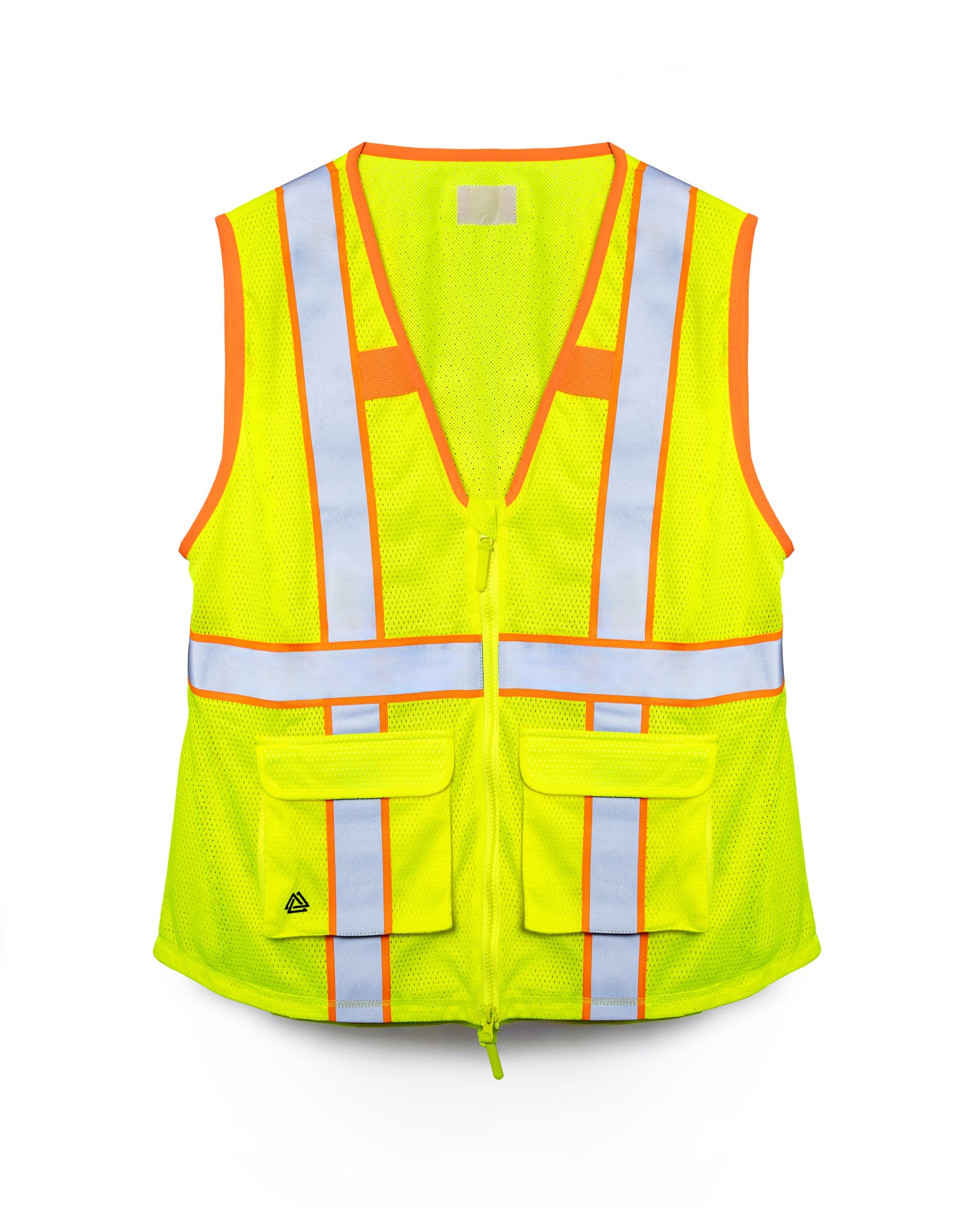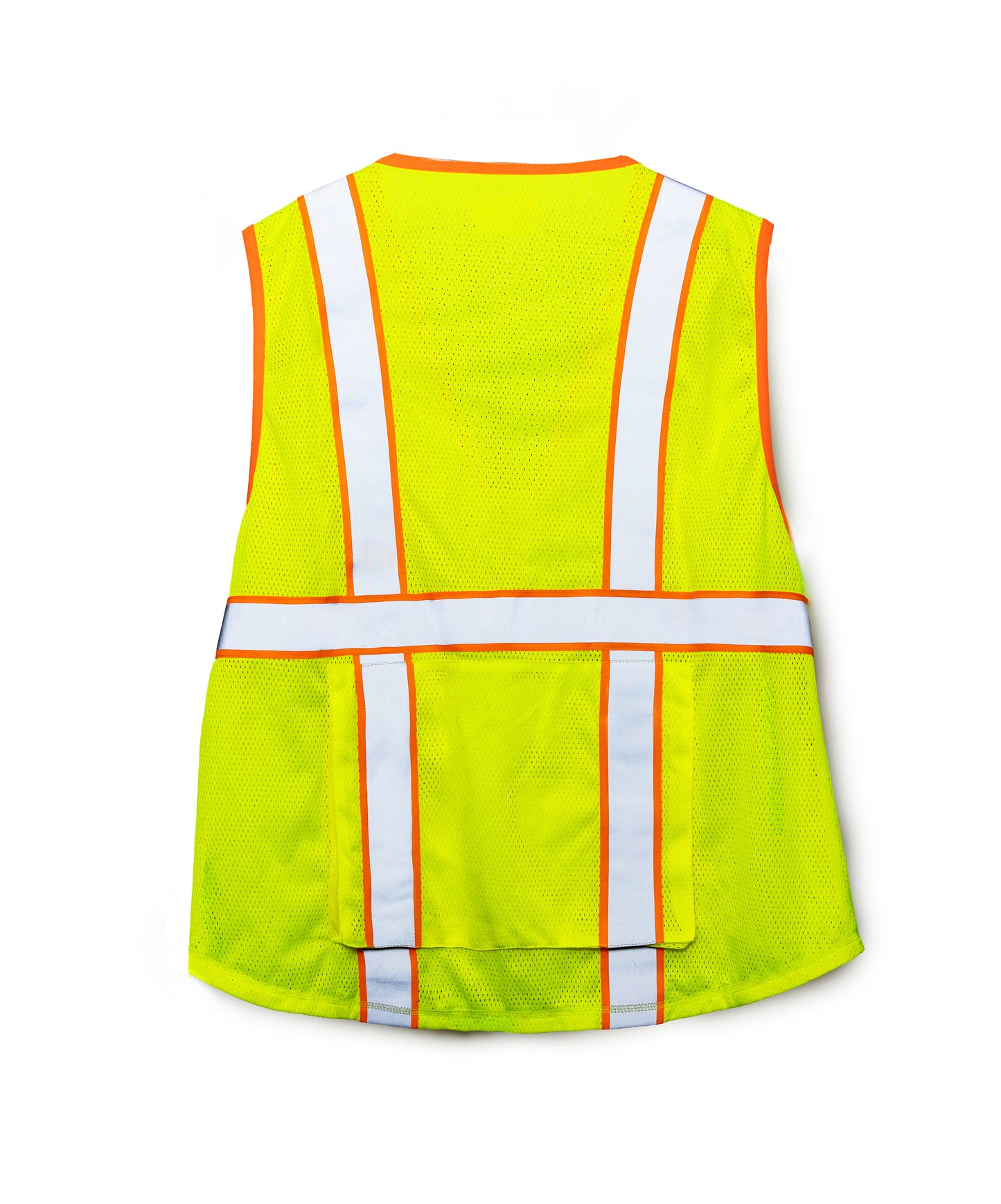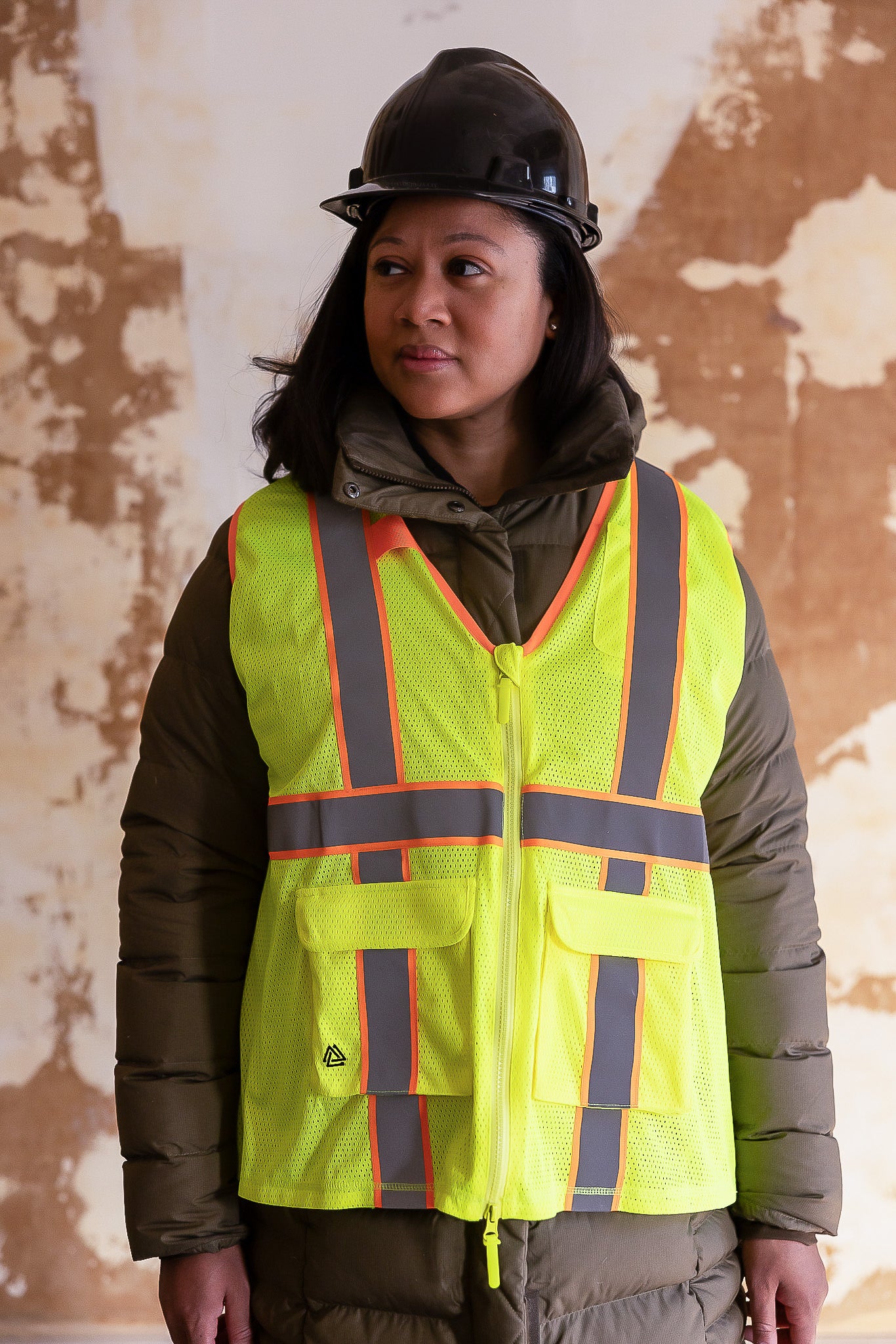The Original Vest
-
Third Party Certified ANSI 107 Class 2 vest
-
Large back pocket for added storage
-
Two front gusset pockets to store your personal or work-related items
-
Large back pocket for added storage
-
Mesh fabric for breathability
-
Hi-Viz yellow fabric to enhance visibility
-
Reflective tape in all the right places to keep you safe and visible
-
Sizing and design compliments a variety of women's shapes
-
Oversize armholes to wear over other garments including coats
-
Adjustable interior drawstring to customize your fit
Size Guide
Size Guide
Women's Sizing
Small: Size 0-4
Medium: Size 6-8
Large: Size 10-14
Couldn't load pickup availability
Instructions for Use
Instructions for Use
ARX “Original Vest” Instructions for Use
DANGER
Read this User Information Guide carefully. All of the instructions contained in it are intended to warn you of potential risks of serious injury and death and to reduce such risks. If they are not heeded and followed, the risk of serious injury or death will increase. No garments can ensure you avoid all serious injuries or death. It is your responsibility to familiarize yourself with this User Information Guide and to use your garments in accordance with its instructions.
Introduction
This User Information Guide gives important information regarding the use, care, and maintenance of your garment. Upon receipt and inspection of the garment, you should thoroughly read this User Information Guide and refer to it as needed for continued safe use of your garment.
Warnings
This garment will not provide protection to you in the event of exposure during a flash fire resulting from the ignition of a hydrocarbon atmosphere or atmosphere containing combustible finely divided particles (such as coal dust or grain) that contains a concentration above the lower explosive limit of the chemical or substance. This garment will also not provide protection to you in the event of an electrical arc flash.
This garment will not protect against any extended exposure to direct flame or high heat and is not intended for use in any firefighting or other emergency operations, including wildland firefighting, technical rescue, or structural firefighting. These garments will also not protect you from exposure to radiological agents, biological agents, or hazardous materials.
This garment alone will not protect you from all hazards. You or your employer must conduct a hazard and risk assessment to determine the suitability of this garment for its intended purpose. Additional garments or personal protective equipment may be necessary to provide you complete protection that includes, but is not limited to head protection, eye/face protection, hand protection, foot protection, respirators, hearing protection, fall protection, high visibility apparel, and other protective garments.
This garment will not protect you if not properly maintained. Do not use this garment if soiled, contaminated, or damaged. Soiling and contamination of this garment may render this garment hazardous. Clean this garment in accordance with the instructions provided in this user information. If you have any doubt about the condition of this garment, do not wear it and have it replaced. You must be trained in recognizing hazards in your specific trade and understand the limitations of use for this garment prior to wearing it.
This garment will not protect you from being burned under all conditions of use or exposure to hazards. Failure to understand the limitations of these limitations may result in a serious injury or death.
Sizing and Fit
Choose a high-visibility vest that properly fits. The garment should not be too tight or too loose, should not restrict your movement, and should be comfortable to wear. The garment sizes are provided in the tables below.
S - Chest Width 18” / Back Length 27”
M – Chest Width 19” / Back Length 27.5”
L/XL – Chest Width 24” / Back Length 30”
Garment Marking and Emblems The use of non-flame or non-heat resistant emblems, shields or patches, embroidery, silkscreens, and heat transfers used to designate a specific organization, title, position, or other professional status, etc. should be avoided. For marking of these garments, it is recommended that any identifications be provided on the interior side of the garment. There is a specific piece of fabric for recording a marking on the back inner portion of the vest near the neck. For hand written marking, an industrial laundry marker may be used.
Donning and Doffing Procedures
This garment is a high-visibility vest with a primary purpose of covering the torso. It should be worn and removed in the following manner:
1. Once all other required PPE is on and ensuring retroreflecting stripes are positioned outside of the garment, place each arm through the arm holes.
2. Fasten the garment in the front at all times. After use, when you are in a safe area, remove the high visibility vest first by:
1. Remove any gloves and/or wash hands if they have any contaminants or hazardous material on them
2. Grab the front fabric near the hook and loop closure, and pull the hook and loop downwards to unfasten the vest.
3. Gently pull the garment around each arm.
Proper Use
The user is responsible to determine that this garment is appropriate for the intended use and complies with all laws and regulatory standards. The user assumes all risks associated with the use of this product. KMHG Corporation shall not be liable for loss, injury, or death arising out of the use of this product.
Inspection and Repair
Periodically inspect your garment as follows:
- Inspect your garment upon receipt, at least once a month, before and after each use, cleaning and/or following any application where the garment has been subjected to damage or contamination. In the event of exposure to hazardous materials, isolate the garment and perform the inspection only after the garment has been decontaminated.
- Inspect all components for rips, tears, burn damage, and abrasion damage. Close attention should be paid to integrity of the thread and areas around the face.
- Physically inspect all seams for structural damage.
- If any component is found to be damaged or missing, remove the clothing from service and have it repaired or replaced.
- Inspect each article of clothing for the following types of wear or damage: • Rips, tears, holes • Brittle/stiff material • Discoloration • Charring • Cleanliness • Other Fabric damage • Seam integrity • Size and fit
Before any repairs are made to your garment, clean your garment in accordance with the instructions provided below.
All repairs to Ergodyne flame-resistant garments should be done at an authorized facility. Contact KMHG Corporation toll free at +1 617-322-2427 to speak to a customer service representative to coordinate the return and repair of the item.
Unauthorized repairs made to KMHG Corporation garments invalidates all expressed or implied warranties and increases your risk for injury to hazardous or life threatening conditions.
Storage
After the garment has been cleaned and inspected, store your garments in a place that will protect them from direct sunlight heat and excessive moisture. Never store your garments in direct sunlight, as this condition may cause permanent damage. Avoid prolonged exposure to sunlight. Exposure to ultraviolet light will cause the garment to lose tensile strength. Once started, there is no way to repair this type of deterioration. Wet garments will promote the growth of mildew and fungus, which will permanently damage your garments.
Cleaning Requirements
- Do not dry clean. Solvents may damage your garment
- Never use chlorine bleach on this station/work uniform under any condition. Chlorine bleaches may discolor the fabrics, and cause garment materials to lose their performance characteristics, such as flame resistance, strength, etc.
- Do not use fabric softeners. Fabric softeners are oil based and can contribute to fabric flammability.
- Do not use automatic dryers. Hot drying temperatures or extended drying time will cause greater material shrinkage.
- Do not use hot water (over 140°F or 60°C). Overly hot water may cause excessive material shrinkage.
- Keep protective garments clean. The garment’s life expectancy increases if abrasive, flammable dirt and contaminants are removed after each use. Garments contaminated with unburned byproducts of combustion, as well as other flammable contaminants, may not only ignite, but the garment may also continue to burn.
Home Machine Washing Instructions
- Turn the garments inside and wash separately from other clothing. The use of home-based washers and washers used by the public are not recommended in order to prevent the spread of contamination to other laundry items.
- B. These instructions can be applied to washing a number of clothing items in the same load. The load size will depend on the machine type and its capacity. Most machines indicate that the load should be no more than 75 to 80% of the machine capacity. For example, a typical home style machine can accommodate up to 12 shirts, 4 pants, 3 sets of pants and shirts, or 5 lightweight jackets.
- While the washing machine is filling up with warm water (temperature at 140°F60°C ± 3°C), add 1 cup (8 oz.) of liquid or powder laundry detergent to the machine. Use 1½ cups of mild detergent if wash water is considered very hard. These detergents are readily available in supermarkets around the country.
- Fill the washing machine to the highest level.
- Add garments to be washed.
- Set washing machine to “normal cycle” or similar setting and double rinse.
- If garments are laundered at outside laundering facilities, the same procedures must be followed to avoid damaging the garments.
Home Drying Instructions
- For best results, allow garment to air dry
- Machine drying is not recommended
Ironing
Do not iron.
External or Institutional Cleaning Services
If outside organizations are used to clean your garments, ensure that the washing and drying procedures are effective in removing soils and other contaminants while not adversely affecting the condition and performance of your garments. These services should use some form of traceability for determining how many times your garment has been cleaned.
Cleaning Blood or Body Fluid Contaminated Garments
Contaminated garments should not be laundered at home.Garments that are obviously contaminated by large amounts of blood or body fluids must be placed and transported in suitable bags that prevent leakage. Personnel involved in the bagging, transport, and laundering of contaminated clothing must wear appropriate protective gloves, aprons and eye/face protection. Separately wash garments in a front loading industrial size washing machine with a liquid or powder laundry detergent at a water temperature of 160°F (60C) for at least 25 minutes, and use multiple rinse cycles. Use of bleach may compromise the structural integrity of the garment and therefore must never be used. Dry as noted above “Home Machine Drying Instructions.” Do not use disinfectants, sanitizing agents, or other specialty chemicals unless their use has been adequately demonstrated for removal of pathogenic bacteria and their use will not damage your garments.
Removal of Hazardous Materials
Garments contaminated from hazardous or caustic materials, such as solvents, liquids, dusts, mists, fumes, and vapors, must be immediately removed from service and retired as directed below in “Retirement and Disposal”.
Unless it can be demonstrated by a qualified, competent authority that the garments can be properly de contaminated and are safe for reuse, your garments must be retired.
Do not use any decontamination agent or process unless it has been adequately demonstrated that its use will not damage your garments.
Retirement and Disposal
You must realize that these garments do not have an indefinite useful life. KMHG Corporation recommends that a regular garment replacement program be conducted by your organization to address the useful service life of these garments. Details of such a program must be developed based on previous experience in the organization as it is impossible to provide a specific time frame for garment replacement. Other retirement considerations should include:
- Garments that have been affected by sunlight, ultraviolet light, or general reuse to the point where the fabrics become stiff or weak;
- Garments that have been affected by improper care procedures; and
- Garments that have been exposed to hazardous or caustic materials that cannot be safely decontaminated.
Garments that have to be retired from service should be destroyed so that they cannot be reused. One suggested method of disposal is cut clothing into pieces and check with your local or state requirements for appropriate methods of disposal since it is possible that contaminants may be present on the garments.
Warranty
We stand behind everything we make and guarantee our products to be free of defects in materials and workmanship to the original purchaser for the lifetime of the product. Damage, abuse, and/or normal wear are not covered. Questions? Call KMHG Corporation at +1 617-322-2427 (9am - 5pm EST).
Share










